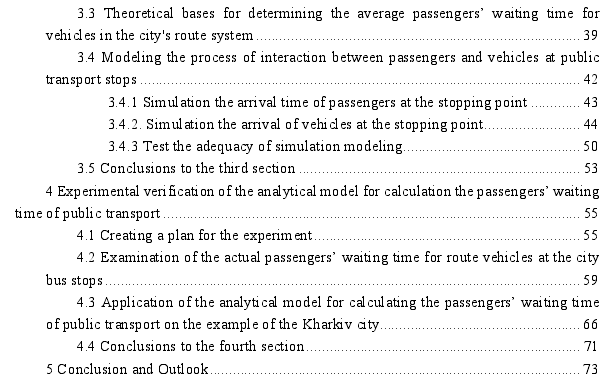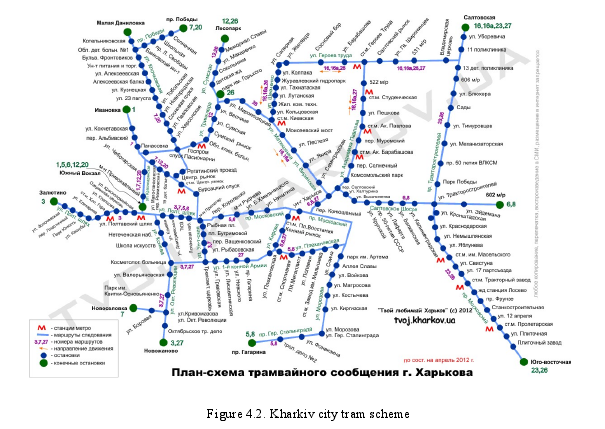物流管理论文哪里有?本文 所获得的理论相关性允许计算特定城市整个城市公共交通系统的乘客等待路线车辆的时间,前提是路线上没有严格的交通计划,乘客提供的下一辆车离开路线站点的准确时间信息。以及组织街道交通路线运行的现有技术,这些技术最符合工作条件,没有预先制定的时间表,时间表中的可变移动间隔。路线上的交通间隔按照伽马分布进行分布,其规模参数与路线上车辆的平均移动间隔呈线性关系,哈尔科夫路线网络站点上的实际乘客等待路线车辆的时间为9.9分钟。
1 Introduction
1.3 Research methods
During the development of the theoretical bases for estimating the passengers’ waiting time for route vehicles, the methods of probability theory and analytical modeling were used. The analysis, formalization, comparison and deductive method were used to identify possible technologies for organizing the operation of vehicles on urban routes and ways of servicing passengers by public transport. In the process of constructing simulation models of passengers’ waiting time for route vehicles on urban routes, induction, regression analysis, methods of probability theory and mathematical statistics were applied to different ways of organizing public transport work. An empirical survey method was used to determine the parameters of public transport on urban routes and to study the actual passengers’ waiting time for route vehicles at stopping points. A hypothetical method and comparison was used to determine the efficiency of passenger service on public transport using a known traffic schedule.

3 Theoretical basics of modeling the passengers’ waiting time of public transport
3.1 Choice of options and their justification for passenger service by public passenger transport
3.1.1 The level of information support for public transport passengers
Currently, in Ukraine in the field of urban passenger transport has formed quite a large number of options for organizing the operation of vehicles on routes. This is due to incomplete fulfillment of functions of the customer of transportation of passengers by city routes by local self-government bodies. In many cities there is no control over adherence to the timetable given in the passports of the routes, sometimes even there is no control over the number of vehicles actually operating on them.
This situation leads to too much freedom of privat transport companies to choose the form of organization of traffic on the routes. Considering that many non-transportation entrepreneurs are involved in this market, there are many different regulated or unregulated variants of interactions between drivers on routes in Ukrainian cities.
In the first case, it is considered that all passengers have a complete understanding of the parameters of urban routes. Then the waiting time is determined solely by the passenger and his / her attitude to the trip as a whole, provided that the drivers have a clear timetable for driving on the routes. In the second case, none of the passengers at all knows the timetable of the vehicles on the route. In this case, the waiting time is random. At the same time, to search for its values, the only possible way to search is to analytically simulate and conduct simulation experiments on the basis of constructed simulation models.
4 Experimental verification of the analytical model for calculation the passengers’ waiting time of public transport
4.1 Creating a plan for the experiment
The object of experimental research is the Kharkiv city public transit route network, which was formed in the Soviet era. It, like the route networks of most other Ukrainian cities, has undergone significant transformations in terms of infrastructure, passenger service technology and route tracing. First of all, this was due to the private initiative of modern transport operators on a large part of urban routes.
Major reorganization changes directly relate to public transport routes, since they do not require significant investment, and the essence of reorganization is to change the route to a more commercially attractive route for the carrier and the customer of transport services, but not always with quality changes for passengers.
Due to the need for large-scale investments and limited state support, the city's ground transportation and subways are slowly developing and branched out, although in Kharkiv, through cooperation with the European Bank for Reconstruction and Development, the subway has expanded its network. This situation in the area of urban passenger transportation is typical for the vast majority of Ukrainian cities, where transport infrastructure is a historical legacy of the Soviet era.
4.2 Examination of the actual passengers’ waiting time for route vehicles at the city bus stops
The difficulty of obtaining empirical values of passengers’ waiting time for route vehicles lies in the randomness of the investigated process and the presence of a considerable number of forms of organization of work of rolling stock on routes that arose in the process of interaction between carriers and local authorities. In addition, carriers do not provide passengers with a sufficient level of information about the modes and schedules of vehicles on routes, and if they are, there is a problem with the performance of drivers of route vehicles of these schedules.
The level of information support for passengers can be limited by two extreme cases: - passengers have a full understanding of the mode and schedule vehicles on the route; - passengers have no idea of the nature of the traffic on the route.
In the first case, the duration of waiting for the passenger transport network at the stopping points is determined individually by the passenger. Each passenger independently plans the trip and predicts in advance the possible waiting time for the transport at the stop.
In the second case, the waiting time is a random variable that depends on the parameters of the traffic of the vehicles on the route and the characteristics of the flow of approach of passengers to the stops of the passenger transport network. In reality, the operating conditions of the city's itinerary networks satisfy the passengers with some intermediate level of information provision on the parameters of the operation of urban transport.

5 Conclusion and Outlook
(1) The theoretical models of calculation of passengers’ waiting time for route vehicles at a bus stop at urban routes have not yet covered the whole spectrum of possible technologies for organizing rolling stock on routes of street passenger transport, require experimental verification, taking into account the actual patterns of behavior and behavior of passengers lead to the need to develop a model for calculating the passengers’ waiting time for route vehicles s route network in order to assess possible outcomes of advanced technologies passenger service.
(2) The main ways to organize the movement of vehicles on the route are options for adhering to a pre-formed schedule on the route or, conversely, work without a rigid schedule. In the first case there are variants of ensuring equal interval of motion without deviations and with normally distributed deviations of the actual departure time from the schedule, as well as a variable interval with two alternating values. In the second case, the technology of sending the vehicle by filling the salon to a predetermined level with the restriction and without limitation of idle time of the vehicle at the initial stop of the route, as well as the accidental departure of the vehicle from the initial stop, is applied. The analytical calculation models developed for these variants of passengers’ waiting time for route vehicles can be used in the modeling of urban transport systems and determining the quality of public passenger transport services, but require experimental verification for the real conditions of functioning of urban passenger transport.
(3) The results of the survey of passengers’ waiting time for route vehicles with a known timetable for 10 tram, trolleybus and bus routes in Kharkiv using the developed methodology showed that the random values of passengers’ waiting time for route vehicles, in case the passenger is aware of time of departure of the vehicle from a stopping point, distributed according to the indicator law with parameter 0.175 and average 5.72 min at the average actual interval of movement of the vehicle on the surveyed routes 26.46 min.
reference(omitted)

